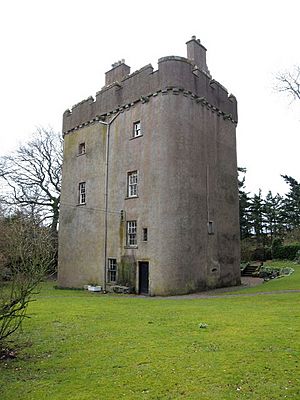Cranshaws Castle facts for kids
Quick facts for kids Cranshaws Castle |
|
|---|---|

Cranshaws Castle
|
|
|
Listed Building – Category A
|
|
| Designated | 9 June 1971 |
| Reference no. | LB4093 |
| Lua error in Module:Location_map at line 420: attempt to index field 'wikibase' (a nil value). | |
Cranshaws Castle or Cranshaws Tower is a privately owned castle from the 1400s. It's a special type of building called a pele tower. You can find it near the village of Cranshaws in Berwickshire, Scotland. This historic building is still used as a home today. It's also protected as a very important category A listed building.
Contents
History of Cranshaws Castle
Early Owners: The Oliphants
The land where Cranshaws Castle stands was first part of a larger area called the Barony of Bothwell. King Malcolm IV gave this land to David Olifard in the mid-1100s. Later, a younger son of the Olifard family was given control of Cranshaws. The Oliphant family kept this estate for many centuries.
In 1329, William Oliphant, Lord of Aberdalgie, who was the head of the younger Oliphant family line, passed away. Cranshaws was one of the properties he left behind.
Around 1336, William Oliphant's lands, including Cranshaws, were taken over by King Edward III. This happened because William had lost his rights to the land.
The Morays and the Douglas Family
In 1252, the Barony of Bothwell passed to the Moray family through marriage. This happened when the main Oliphant family line ended. Later, in 1362, Joanna de Moravia, who was the heiress of Bothwell, married Archibald Douglas, 3rd Earl of Douglas. Their son, Archibald Douglas, 4th Earl of Douglas (born 1372), became the next heir.
In 1401, Archibald Douglas, 4th Earl of Douglas, gave Cranshaws to Sir John Swinton. He called Sir John his "beloved cousin." This meant the Oliphants lost their control of Cranshaws. Sir John Swinton died in battle the next year. His son, Sir John Swinton, then took over the lands. It is believed that this Sir John Swinton built the castle we see today. We don't know what kind of building the Oliphants had before.
Disputes Over Ownership
For most of the 1400s, there was a big argument about who truly owned Cranshaws. The Oliphant family felt they had been unfairly removed from their land.
- In 1412, Walter Oliphant was still called the Lord of Aberdalgie, which included Cranshaws.
- In 1442, Sir John Oliphant was declared the rightful heir to Cranshaws. However, the very next day, Sir John Swinton of that Ilk challenged this claim.
- In 1464, an official investigation was held to settle the argument between the Swintons and Lord Oliphant.
- In 1474, Lord Oliphant asked the courts to confirm his ownership of Cranshaws.
- In 1476, Lord Oliphant made an agreement with Alexander, Duke of Albany. He agreed to pay for the years his family had not officially owned Cranshaws. The Duke also gave Lord Oliphant permission to try and get back any money or goods that Sir John Swinton had taken from the lands.
- Also in 1476, Lord Oliphant tried to take back Cranshaws by force. He "raided" the castle and took oxen and horses.
Later Owners and Renovations
In the 1700s, another part of the Douglas family, the Earls of Morton, bought the castle. George Douglas, 13th Earl of Morton (1662–1738), made many changes and improvements to the building.
The castle was repaired again in 1896 and 1897 by Andrew Smith. In 1931, it passed to his nephew, Stenhard Landale.
How Cranshaws Castle Was Built
Cranshaws Castle is a rectangular keep. A keep is the strongest and most protected part of a castle. This castle has four floors and rounded corners.
Originally, the castle would have had a defensive wall around it called a barmkin. This wall would have helped protect the castle, but there are no parts of it left today. The top of the castle has a special wall with gaps, called a crenellated parapet. This part is thought to have been added in the late 1800s.
Stories and Folklore
Cranshaws Castle is believed to be the inspiration for "Ravenswood Castle." This is the home of Edgar, a main character in the famous book The Bride of Lammermoor by Sir Walter Scott.
People also say that a Brownie lives at Cranshaws Castle. A Brownie is a helpful, magical creature from Scottish folklore.

